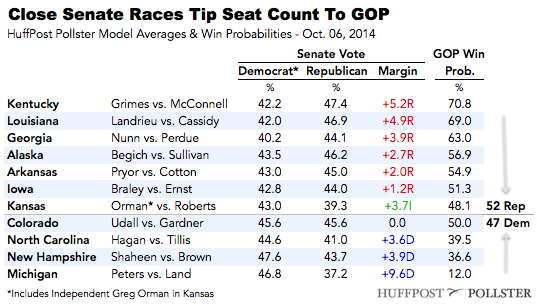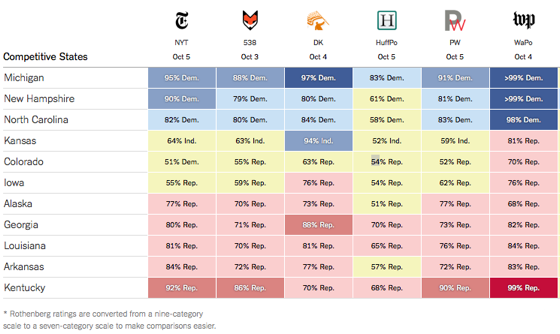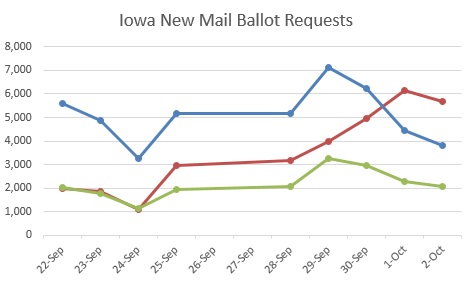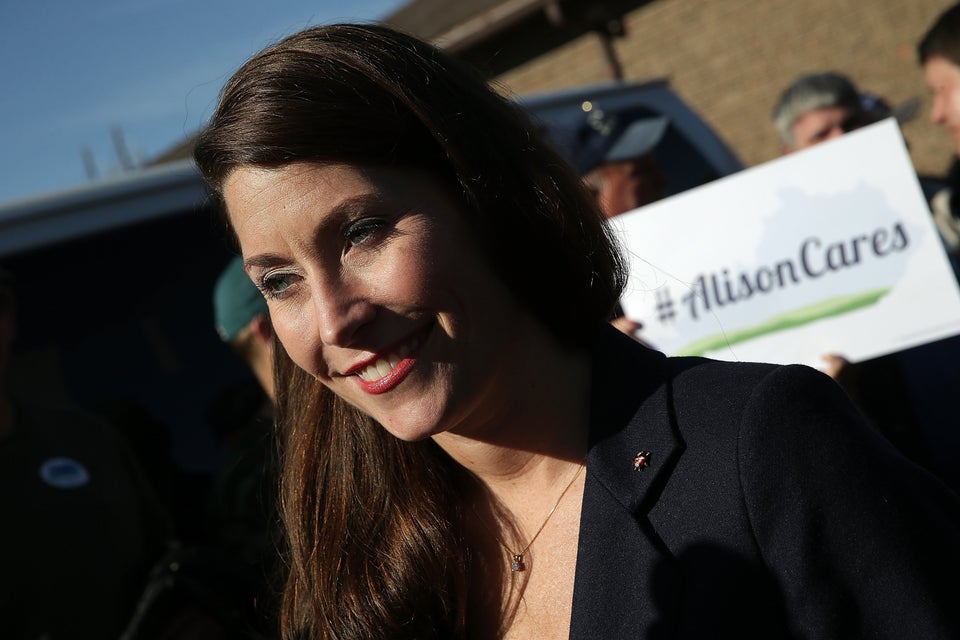
It was a busy weekend for polls, with new data showing a still close race for control of the Senate with a slight edge for the Republicans. Surveys show Kansas leaning toward an independent. And both sides may find encouraging news in the early voting statistics in Iowa. This is HuffPollster for Monday, October 6, 2014.
NEW SENATE POLLS, SIMILAR OUTLOOK - A huge batch of polling released over the weekend leaves the race for the U.S. Senate looking close but still tipping to the Republicans, with the overall outlook just a hair better for Democrats than it was previously. New polls from NBC News/Marist and New York Times/CBS/YouGov largely reinforce the existing polling snapshot, but nudged the numbers toward Democratic candidates in Iowa, Colorado, Michigan and toward independent candidate Greg Orman in Kansas.
To win majority control of the Senate, Republicans need to prevail in three of four contests where the polling margins estimated by the HuffPost Pollster poll tracking model remain close. As of this writing, Republican candidates hold narrow edges in three of these states Alaska, Arkansas and Iowa, with Colorado an exact tie. Our model rates the probability of a Republican win at or just barely over 50 percent in each of the four, much like the model's assessment of the overall probability of a Republican majority -- 52 percent as of this writing. [HuffPost Pollster Senate Forecast]
Democrats have a path to holding their majority, but it is narrow. If they can maintain their current leads in North Carolina and Michigan and prevail in just two of the closest states -- in Colorado and Iowa, for example -- control of the U.S. Senate could be decided by independent candidate Greg Orman in Kansas, who now holds a better than 3 percentage point lead in the polling average (although just a 52 percent probability of winning). Orman has pledged to join the majority party should he win, but has not committed to either party in the event Republicans hold just 50 Senate seats.
Why does HuffPost give Republicans a smaller probability of a Senate majority than other models? - As summarized in the graphic (below) produced by The New York Times, although the various news media models largely agree on which party leads in each of the Senate contests, the HuffPost Pollster model is less certain across the board that the leaders will win. We designed the model to reflect the potential that polls could be wrong, given the historical real-world accuracy of pre-election polling, and the time remaining until votes are cast a the percentage that remain undecided.
A closer look at some of the state polling - HuffPollster: "[T]he newest surveys push Sen. Kay Hagan (D-N.C.) up to a 61 percent chance of winning, edging North Carolina out of the tossup camp. Hagan's advantage, though sometimes small, has been consistent over the past month. The 13 most recent polls in the state, including those by partisan pollsters, have all shown her ahead by at least 1 percentage point….Another reason for the slight shift in GOP fortunes: Michigan has also turned more solidly Democratic, with the forecast now giving Rep. Gary Peters an 88 percent chance of victory….In Colorado, the Pollster model gives Sen. Mark Udall (D) a 50 percent chance of holding his seat against Rep. Cory Gardner (R). Sunday's CBS/NYT/YouGov poll is the first since early September to show Udall ahead….The latest surveys in Iowa have been more varied, with several showing a clear edge for state Sen. Joni Ernst (R) and others finding her deadlocked against Rep. Bruce Braley (D). The NBC/Marist and CBS/NYT/YouGov polls lean toward the latter camp, finding a 2-point edge for Ernst and a 1-point edge for Braley, respectively. The Pollster model finds the two effectively tied." [HuffPost]
And a spotlight on Kansas - "An NBC/Marist poll released Sunday finds Orman leading Roberts by 10 points, 48 percent to 38 percent, among likely voters. Five percent chose libertarian Randall Batson, and the remaining voters were undecided or opting for yet another candidate….While Democrats are about as unpopular as you might expect in Kansas -- 54 percent of registered voters disapprove of Barack Obama's record as president -- voters are also 6 points more likely to disapprove of Republicans in Congress than of Democrats in Congress. Most polling has found Orman ahead by several points since the Kansas Supreme Court ruled that Democrat Chad Taylor, who withdrew from the race, could remove his name from the ballot, but NBC/Marist results give him his largest advantage to date. A second poll released Sunday, however, finds Roberts and Orman tied. The New York Times' Nate Cohn notes one possible reason for the disparity: The second survey,conducted by YouGov for CBS and the Times, finds 19 percent of Democrats undecided, much higher than in other polls." [HuffPost]
POLLSTERS PREDICT GREATER ERROR - Carl Bialik: "We wanted to see what the most prolific political pollsters had to say about their work, the election, their industry and where it’s headed. We reached out to 60 of the most active political pollsters in the country, and 26 took our survey….Fifteen pollsters told us their response rates for election polls this year and in 2012. The average response rate this year is 11.8 percent — down 1.9 percentage points from 2012. That may not sound like a lot, but when fewer than one in seven people responded to polls in 2012, there wasn’t much room to drop. It’s a decline of 14 percent, and it’s consistent across pollsters — 12 of the 15 reported a decline, and no one reported an increase....We asked pollsters if they expected more or less error in Senate election polls — the difference between what the latest pre-election polls show and actual vote margins — this year than two years ago. Ten said they expected a higher average error, while just five predicted lower error...the top reason cited was the difficulty of forecasting turnout in midterm elections, without a presidential race to bring voters to the polls. And the crucial midterms are in states that don’t usually have close races. 'The key Senate battlegrounds this year are also places like Alaska, Arkansas, Kansas, Louisiana, etc., where most of the public pollsters don’t have a ton of experience,' one pollster said. 'It’s not the Ohios and Pennsylvanias and Floridas of the world that we’re all used to polling a lot.'" [538]
IS OBAMA A MIDTERM LIABILITY? - Jeffrey M. Jones: "Registered voters are more likely to view their choice of candidate in this year's midterm elections as a message of opposition (32%) rather than support (20%) for President Barack Obama. That 12-percentage-point margin is similar to what Gallup measured for Obama in 2010 and George W. Bush in 2006, years in which their parties performed poorly in the midterm elections….The president is always a major factor in midterm elections, with his party typically losing seats in Congress. And it is clear, based on his lower approval ratings and that more voters say they will be voting as a means of showing opposition rather than support for the president, that Obama is more of a liability than an asset to Democratic candidates this year." [Gallup]
MORE DEMOCRATS VOTING EARLY IN IOWA - Michael McDonald: "I track...early voting statistics for states and localities that publicly report them...The majority of these voters reside in Iowa, where an intense ground game is underway...Since Democrats started with more ballot requests, they've had more ballots returned. As of Thursday, Democrats enjoy a 31,437 (51 percent) to 20,732 (33 percent) lead in returned ballots, a lead in percentage terms that has remained fairly steady during the course of the week. New ballot requests may signal the future, and here Republicans have something to look forward to. Democrats reached a peak for new ballot requests on Monday, Sept. 29, with 7,106 coming in the previous Friday and the over weekend. During the week their new requests steadily declined day to day, reaching 3,806 on Thursday. While Democrats have been in the doldrums, Republicans have sailed a strong wind past the Democrats on new ballot requests. Republicans started the week with 3,966 new requests and steadily increased during the week, with just a slight dip down to 5,660 on Thursday." [Huffpost, McDonald's Elections Project]
HUFFPOLLSTER VIA EMAIL! - You can receive this daily update every weekday morning via email! Just click here, enter your email address, and and click "sign up." That's all there is to it (and you can unsubscribe anytime).
MONDAY'S 'OUTLIERS' - Links to the best of news at the intersection of polling, politics and political data:
-President Obama's job approval rating among Latinos falls in September. [Gallup]
-Americans give low ratings to congressional leaders. [Gallup]
-David Leonhardt look ahead to the future of polling. [NYT]
-Harry Enten finds the new NPR Senate Battleground shows the same result as an average of polling averages. [538]
-Public Policy Polling notes an intriguing similarity. [@ppppolls]
-Megan Thee-Brenan doubts President Obama will get credit for a falling unemployment rate. [NYT]





